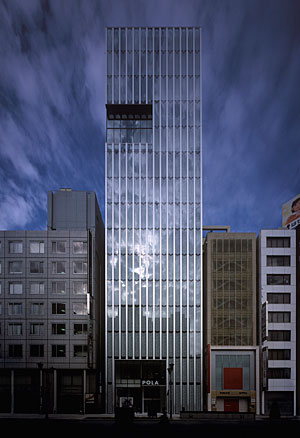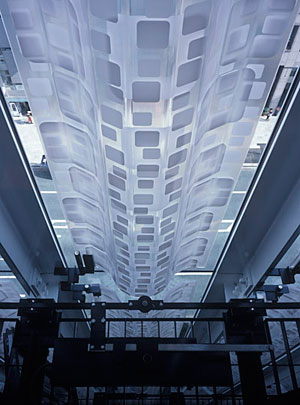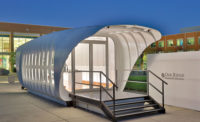

“Transformable design” is the term that Chuck Hoberman uses to describe the focus of his multidisciplinary practice, Hoberman Associates. The 19-year-old New York City-based firm fuses sculpture, engineering, and product design to create objects with the ability to change size and shape. It is perhaps best known for the Hoberman Sphere, which relies on a series of scissor-like joints to collapse from an open polyhedron to a tightly packed sphere. It has been fabricated in many sizes, all the way from a palm-sized toy to a giant sculpture found at the Liberty Science Museum in Jersey City. But Hoberman’s oeuvre also includes retractable domes, medical instruments, and a stage for the Salt Lake City Winter Olympics.
The firm is also applying its expertise with kinetic objects to buildings in order to create automated and responsive enclosures that can provide shading or ventilation. Facades are ripe for such adaptive components, according to Hoberman. “The envelope plays the single largest role in building performance,” he says. “Not only in relationship to energy consumption, but also with regard to occupant comfort.”
Hoberman, who has envelope projects under way with Foster + Partners and Kohn Pederson Fox, among others, completed his first building with an adaptive skin in October—a mixed-use tower on Tokyo’s Ginza. The 15-story structure, designed by Japanese architecture firms Nikken Sekkei and Yasuda Atelier, houses a showroom for cosmetics company POLA on the lower floors and commercial office space on the upper levels. Within the 3-foot-deep cavity of its street-facing double-skin facade, 185 polycarbonate operable shutters shield the interiors behind the all-glass southeast elevation from direct sunlight. Photo sensors and a building management system control the translucent shading devices, helping cut heat gain by as much as 10 percent, says Hoberman. At night, the shutters move in concert with a colorful lighting scheme.
To further the development of responsive facades, Hoberman’s firm has formed a 50/50 joint venture with global engineering consultancy Buro Happold. The two companies have a long history of working together on transformable structures, including a rapidly deployable shelter for Johnson Outdoors and an expanding elliptical video screen for band U2. But the new Hoberman-Happold entity, named the Adaptive Building Initiative (ABI), differs from these previous collaborations. Instead of providing services on a project-by-project basis, ABI will focus on longer-term technology development with the ultimate goal of creating unitized, dynamic envelope assemblies. The joint venture is working to form partnerships with fabricators and manufacturers so that it can “deliver not only design and engineering, but complete adaptive systems,” says Hoberman. The ABI partners hope to make such systems commercially available within three to five years.







Post a comment to this article
Report Abusive Comment